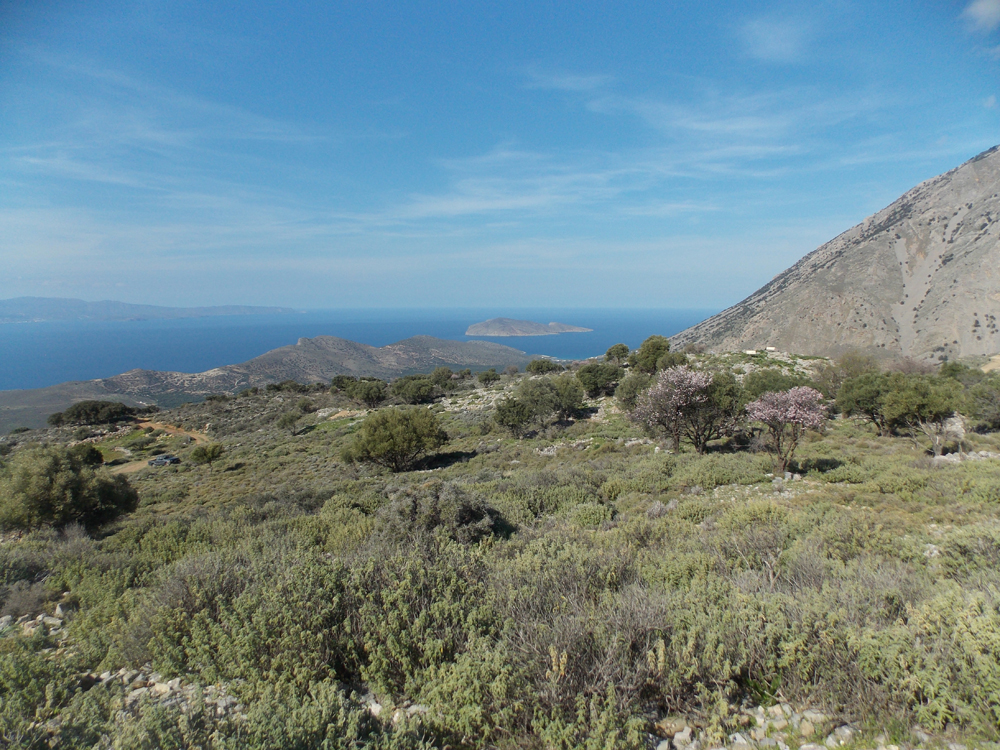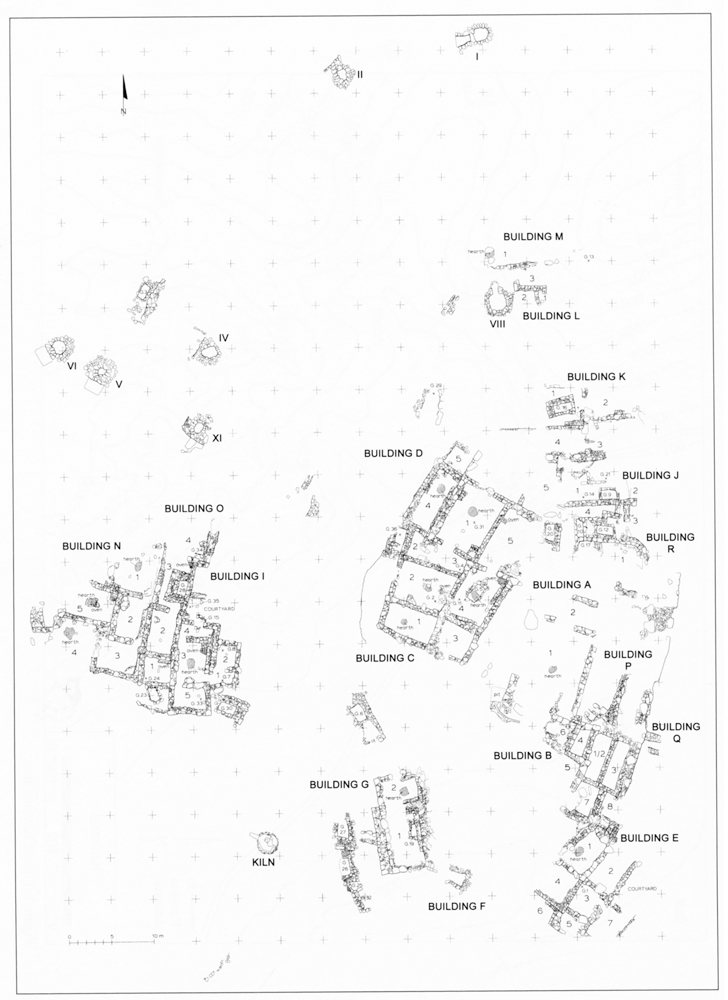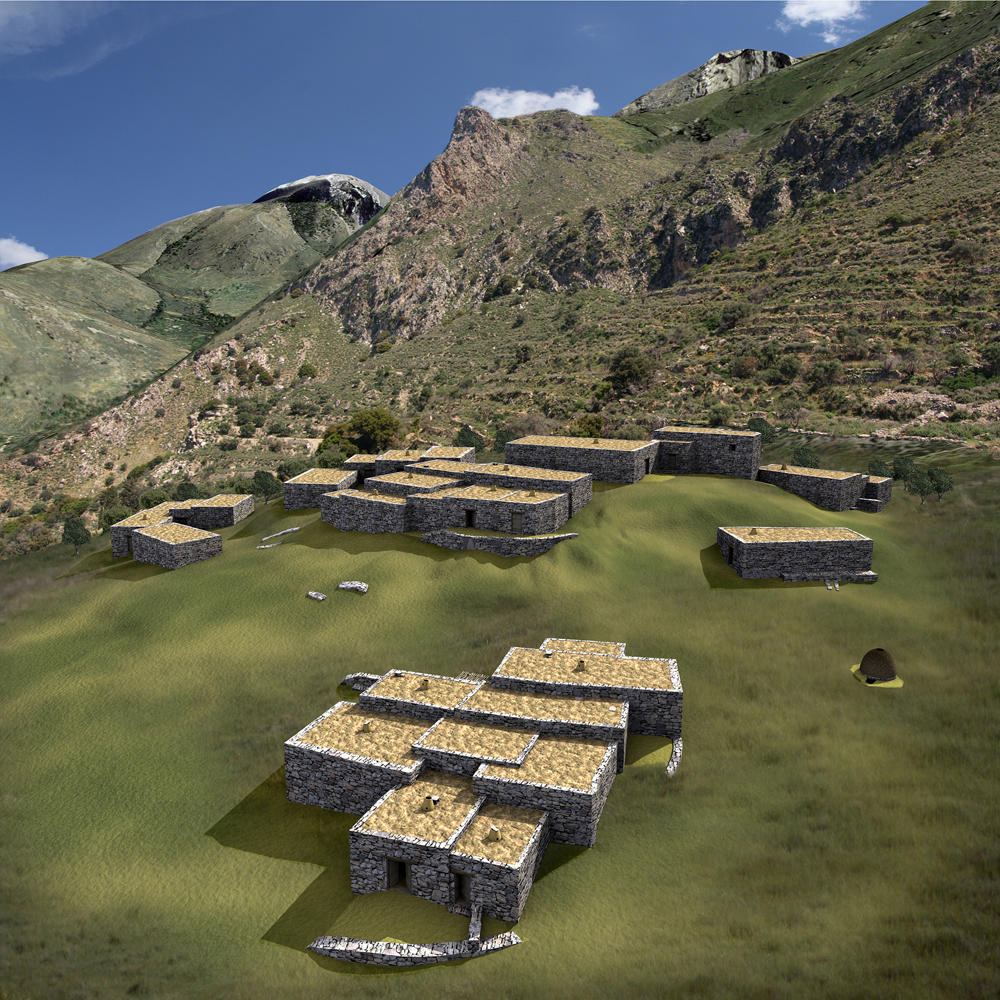The site of Vronda is located on the top of a mountain ridge (427 m above sea level) south of the village of Kavousi in eastern Crete.

It was first explored by Harriet Boyd in 1900 and extensively excavated as part of the Kavousi Project (1987–1992), under the direction of William Coulson, Leslie Day, and Geraldine Gesell. Although there is evidence of activity at the site in numerous periods—Final Neolithic, Early Minoan (EM) II–III (a probable settlement with no preserved architecture), Middle Minoan (MM) II (a significant settlement, which included Building P), and Neopalatial (MM III–Late Minoan [LM] IA pottery deposits)—the primary period of occupation is Late Minoan IIIC.
The LM IIIC settlement (ca. 1200–1100 B.C.) was organized into seven building complexes separated by open spaces and pathways. Building Complexes C-D, E, I-O-N, J-K, and L-M consist of approximately 15 houses, which were constructed in an agglomerative fashion and organized into clusters or neighborhoods.


These houses vary in size and plan (2–5 rooms), but each had a large room with a central hearth (and often an oven), and they contained similar artifacts for food processing, preparation, consumption, and storage. A significantly larger structure (Building A-B) with specialized storage facilities (containing large pithoi) was located on the summit of the hill; this building may have served as an elite residence (for a ruler, “chieftain,” or “big man”) and/or a ceremonial center for ritual feasting and drinking (based partially on the presence of a large number of kylikes). A freestanding community shrine (Building G) from which were recovered ceramic fragments of 26 “goddesses with upraised hands,” snake tubes, kalathoi, and plaques, was found to the southwest of Building A-B, and a contemporary kiln was uncovered nearby.
Vronda was abandoned at the end of the LM IIIC period and then was used for burials. Remains of 10 small tholos tombs (ca. 1100–850 B.C.) were found immediately to the north of the settlement, and cist graves with cremation burials were placed in nearly all rooms of the site in the Late Geometric and Early Orientalizing periods (760–660 B.C.). The site was apparently not occupied again until the Venetian period (houses—Buildings F and R).
The site of Vronda can be reached by a road (signed), which begins at the eastern end of the village of Kavousi or on foot following a kalderimi (paved path—not signed), which begins at the top (southern side) of the village. Although a road leads directly to the site, a small rental car likely will not be able to make it all of the way due to the condition of the road after it branches off the main, cement-paved road (which also leads to the “ancient olive tree”). Estimated walking time from the village to the site for either the route on the main road or on the kalderimi is approximately 30–45 minutes. The site is unguarded and open, and there are also several informational signs.










Slide show from left to right, top to bottom (click on each photo to enlarge): six images of the team approaching and working on site, two more of the team studying finds from the Late Geometric cemetery, one photo of the study of the Late Minoan IIIC shrine, and a photo of the information signs at the site.
Selected Bibliography
Boyd, H.A. 1901. “Excavations at Kavousi, Crete, in 1900,” AJA 5, pp. 125–157. DOI: 10.2307/496766.
Day, L.P., W.D.E. Coulson, and G.C. Gesell. 1986. “Kavousi, 1983–1984: The Settlement at Vronda,” Hesperia 55, pp. 355–387. DOI: 10.2307/148175.
Day, L.P., H.M.C. Dierckx, K. Flint-Hamilton, G.C. Gesell, K.T. Glowacki, N.L. Klein, D.S. Reese, and L.M. Snyder. 2016. Kavousi IIC: The Late Minoan IIIC Settlement at Vronda. Specialist Reports and Analyses (Prehistory Monographs 52), Philadelphia.
Day, L.P., and K.T. Glowacki. 2012. Kavousi IIB: The Late Minoan IIIC Settlement at Vronda. The Buildings on the Periphery (Prehistory Monographs 39), Philadelphia.
Day, L.P., N.L. Klein, and L.A. Turner. 2009. Kavousi IIA: The Late Minoan IIIC Settlement at Vronda. The Buildings on the Summit (Prehistory Monographs 26), Philadelphia.
Gesell, G.C., W.D.E. Coulson, and L.P. Day. 1991. “Excavations at Kavousi, Crete, 1988,” Hesperia 60, pp. 145–177. DOI: 10.2307/148085.
Gesell, G., L. Day, and W. Coulson. 1983. “Excavations and Survey at Kavousi, 1978–1981,” Hesperia 52, pp. 389–420. DOI: 10.2307/147972.
———. 1988. “Excavations at Kavousi, Crete, 1987,” Hesperia 57, pp. 279–301. DOI: 10.2307/148100.
———. 1995. “Excavations at Kavousi, Crete, 1989 and 1990,” Hesperia 64, pp. 67–120. DOI: 10.2307/148260.
